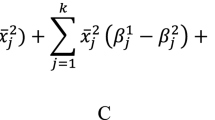Abstract
This paper proposes a conditional Curie–Weiss model as a model for decision making in a stylized society made up of binary decision makers that face a particular dichotomous choice between two options. Following Brock and Durlauf (Discrete choice with social interaction I: theory, 1955), we set-up both socio-economic and statistical mechanical models for the choice problem. We point out when both the socio-economic and statistical mechanical models give rise to the same self-consistent equilibrium mean choice level(s). Phase diagram of the associated statistical mechanical model and its socio-economic implications are discussed.




Similar content being viewed by others
References
Durlauf, N.S.: How can statistical mechanics contribute to social science? Proc. Natl. Acad. Sci. USA 96, 10582–10584 (1999)
Brock, W.A., Durlauf, S.N.: Discrete choice with social interaction. Rev. Econ. Stud. 68, 235–260 (2001)
McFadden, D.: Econometric models of probabilistic choice among products. J. Bus. 53(3), S13–S29 (1980)
Anderson, E.: Streetwise. University of Chicago Press, Chicago (1990)
Case, A., Katz, L.: The Company You Keep: The Effects of Family and Neighborhood on Disadvantaged Families (National Bureau of Economic Research Working Paper No. 3705) (1991)
Crane, J.: The epidemic theory of ghettos and neighborhood effects on dropping out and teenage childbearing. Am. J. Sociol. 96, 1226–1259 (1991)
Glaeser, E., Sacerdote, B., Scheinkman, J.: Crime and social interactions. Q. J. Econ. 106, 507–548 (1996)
Haveman, R., Wolfe, B.: Succeeding Generations. Russell Sage Foundation, New York (1994)
Jaynes, E.T.: Information theory and statistical mechanics. Phys. Rev. 106, 620–630 (1957)
Gallo, I., Barra, A., Contucci, P.: Parameter evaluation of a simple mean-field model of social interaction. Math. Models Methods Appl. Sci. 19, 1427 (2009)
Gallo, I., Barra, A., Contucci, P.: A minimal model for the imitative behaviour in social decision making: theory and comparison with real data. Math. Models Methods Appl. Sci. 19, 1427 (2009)
Gallo, I., Contucci, P.: Bipartite mean-field spin systems: existence and solution. Math. Phys. Electron. J. 14(1), 1–22 (2008)
Barra, A., Agliari, E.: A statistical mechanics approach to Granovetter theory. Physica A 391, 3017–3026 (2012)
Agliari, E., Barra, A., Contucci, P., Sandell, R., Vernia, C.: A stochastic approach for quantifying immigrant integration: the Spanish test case. New J. Phys. 16, 103034 (2014)
Barra, A., Contucci, P., Sandell, R., Vernia, C.: An analysis of a large dataset on immigrant integration in Spain. The statistical mechanics perspective on social action. Sci. Rep. https://doi.org/10.1038/srep04174. Article number: 4174 (2014)
Contucci, P., Vernia, C.: Alienation in Italian cities. Social network fragmentation from collective data. arXiv:1410.0501
Agliari, E., Barra, A., Schiavo, L.D., Moro, A.: Complete integrability of information processing by biochemical reaction. Sci. Rep. 6, 36314 (2016). https://doi.org/10.1038/srep36314
Brock, W.A., Durlauf, S.N.: Discrete Choice with Social Interaction I: Theory. NBER Working Paper Series (1995)
Cooper, R., John, A.: Coordinating coordination failures in Keynesian models. Q. J. Econ. CIII, 441–464 (1988)
Ellis, R.S.: Entropy, Large Deviations and Statistical Mechanics, Classics in Mathematics. Springer, Berlin (1985)
Manski, C.: Identification problems in the social sciences. In: Marsden, P. (ed.) Sociological Methodology, vol. 23. Basil Blackwell, Cambridge (1993)
Manski, C.: Identification of endogenous social effects: the reflection problem. Rev. Econ. Stud. 60, 531–542 (1993)
Fekete, M.: Über die Verteilung der Wurzeln bei gewissen algebraischen Gleichungen mit ganzzahligen Koeffizienten. Mathematische Zeitschrift 17(1), 228249 (1923). https://doi.org/10.1007/BF01504345
Schelling, T.: Hockey helmets, concealed weapons and daylight savings: a study of binary choice with externalities. J. Confl. Resolut. 17, 381–428 (1973)
Acknowledgements
The authors thank the anonymous referee, to an earlier version of this paper, who gave us various suggestions to improve the paper and also brought to our attention the literature on discrete choice.
Author information
Authors and Affiliations
Corresponding author
Rights and permissions
About this article
Cite this article
Opoku, A.A., Edusei, K.O. & Ansah, R.K. A Conditional Curie–Weiss Model for Stylized Multi-group Binary Choice with Social Interaction. J Stat Phys 171, 106–126 (2018). https://doi.org/10.1007/s10955-018-1988-y
Received:
Accepted:
Published:
Issue Date:
DOI: https://doi.org/10.1007/s10955-018-1988-y
Keywords
- Binary choice
- Social interaction
- Social utility
- Private utility
- Phase transition
- Curie–Weiss model
- Critical temperature
- External field




